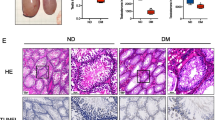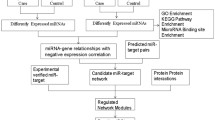Abstract
Background
In the epididymis of bilateral castrated male rat, gene expression profile changed significantly. However, up to date, no study has investigated how these genes were regulated by microRNAs (miRNAs).
Objective
We investigated the alterations in the miRNA signature of the epididymis from sham-operated and bilaterally castrated rats.
Methods
By employing deep sequencing technology and qPCR, the global alterations of epididymal miRNA signature between sham-operated (Con-EP library) and bilaterally castrated rats (Cas-EP library) were explored. MiRNA-target interaction networks were annotated by GO and KEGG enrichment.
Results
We identified 313 and 306 known miRNAs as well as 152 and 114 novel miRNAs in the Con-EP and Cas-EP libraries, respectively. 59 miRNAs were differentially expressed, including 24 up-regulated and 35 down-regulated miRNAs, among which two up-regulated and three down-regulated ones were validated using qPCR. The expression of these miRNAs in the epididymides of rats at different postnatal ages showed regular changes from birth to adult, suggesting they were androgen-regulated. GO analysis showed that many of the miRNA targets were enriched in metabolic processes. KEGG analysis demonstrated that the targets mainly participated in the mitogen-activated protein kinase (MAPK) pathway. Moreover, 3 and 6 functional modules were detected among the up- and down-regulated miRNA target interaction networks, respectively, and these modules were involved in various biological processes.
Conclusion
This study represents the first systematic investigation of alterations in the miRNA signature of the epididymis from bilaterally castrated rats and will provide useful resources for functional studies of the miRNAs in the male reproductive system.





Similar content being viewed by others
References
Bader GD, Hogue CW (2003) An automated method for finding molecular complexes in large protein interaction networks. BMC Bioinform 4:2
Bao J, Li D, Wang L, Wu J, Hu Y, Wang Z, Chen Y, Cao X, Jiang C, Yan W et al (2012) MicroRNA-449 and microRNA-34b/c function redundantly in murine testes by targeting E2F transcription factor-retinoblastoma protein (E2F-pRb) pathway. J Biol Chem 287:21686–21698
Bartel DP (2004) MicroRNAs: genomics, biogenesis, mechanism, and function. Cell 116:281–297
Bartel DP (2009) MicroRNAs: target recognition and regulatory functions. Cell 136:215–233
Brooks DE (1977) The androgenic control of the composition of the rat epididymis determined by efferent duct ligation or castration. J Reprod Fertil 49:383–385
Brooks DE (1981) Metabolic activity in the epididymis and its regulation by androgens. Physiol Rev 61:515–555
Brooks DE, Higgins SJ (1980) Characterization and androgen-dependence of proteins associated with luminal fluid and spermatozoa in the rat epididymis. J Reprod Fertil 59:363–375
Chan B, Manley J, Lee J, Singh SR (2015) The emerging roles of microRNAs in cancer metabolism. Cancer Lett 356:301–308
Chen C, Ridzon DA, Broomer AJ, Zhou Z, Lee DH, Nguyen JT, Barbisin M, Xu NL, Mahuvakar VR, Andersen MR et al (2005) Real-time quantification of microRNAs by stem-loop RT-PCR. Nucleic Acids Res 33:e179
Clermont Y, Flannery J (1970) Mitotic activity in the epithelium of the epididymis in young and old adult rats. Biol Reprod 3:283–292
Cornwall GA, Lareyre JJ, Matusik RJ, Hinton BT, Orgebin-Crist MC (2002) Gene expression and epididymal function. In: Robaire B, Hinton BT (eds) The epididymis: from molecules to clinical practice. Kluwer Academic/Plenum, New York, pp 169–199
Ezer N, Robaire B (2003) Gene expression is differentially regulated in the epididymis after orchidectomy. Endocrinology 144:975–988
Fan X, Robaire B (1998) Orchidectomy induces a wave of apoptotic cell death in the epididymis. Endocrinology 139:2128–2136
Franceschini A, Szklarczyk D, Frankild S, Kuhn M, Simonovic M, Roth A, Lin J, Minguez P, Bork P, von Mering C et al (2013) STRING v9.1: protein-protein interaction networks, with increased coverage and integration. Nucleic Acids Res 41:D808–D815
Hinton BT, Galdamez MM, Sutherland A, Bomgardner D, Xu B, Abdel-Fattah R, Yang L (2011) How do you get six meters of epididymis inside a human scrotum? J Androl 32:558–564
Lewis BP, Shih IH, Jones-Rhoades MW, Bartel DP, Burge CB (2003) Prediction of mammalian microRNA targets. Cell 115:787–798
Lize M, Pilarski S, Dobbelstein M (2010) E2F1-inducible microRNA 449a/b suppresses cell proliferation and promotes apoptosis. Cell Death Differ 17:452–458
Lize M, Klimke A, Dobbelstein M (2011) MicroRNA-449 in cell fate determination. Cell Cycle 10:2874–2882
Robaire B, Hamzeh M (2011) Androgen action in the epididymis. J Androl 32:592–599
Shi XB, Xue L, Yang J, Ma AH, Zhao J, Xu M, Tepper CG, Evans CP, Kung HJ, deVere White RW (2007) An androgen-regulated miRNA suppresses Bak1 expression and induces androgen-independent growth of prostate cancer cells. Proc Natl Acad Sci USA 104:19983–19988
Sun Y, Liu WZ, Liu T, Feng X, Yang N, Zhou HF (2015) Signaling pathway of MAPK/ERK in cell proliferation, differentiation, migration, senescence and apoptosis. J Recept Signal Transduct Res 35:600–604
Trapnell C, Williams BA, Pertea G, Mortazavi A, Kwan G, van Baren MJ, Salzberg SL, Wold BJ, Pachter L (2010) Transcript assembly and quantification by RNA-Seq reveals unannotated transcripts and isoform switching during cell differentiation. Nat Biotechnol 28:511–515
Turner TT (2008) De Graaf’s thread: the human epididymis. J Androl 29:237–250
Wang G, Wang Y, Feng W, Wang X, Yang JY, Zhao Y, Liu Y (2008) Transcription factor and microRNA regulation in androgen-dependent and -independent prostate cancer cells. BMC Genom 9(Suppl 2):S22
Wong KY, Yu L, Chim CS (2011) DNA methylation of tumor suppressor miRNA genes: a lesson from the miR-34 family. Epigenomics 3:83–92
Wu J, Bao J, Kim M, Yuan S, Tang C, Zheng H, Mastick GS, Xu C, Yan W (2014) Two miRNA clusters, miR-34b/c and miR-449, are essential for normal brain development, motile ciliogenesis, and spermatogenesis. Proc Natl Acad Sci USA 111:E2851–E2857
Xu B, Yang L, Lye RJ, Hinton BT (2010) p-MAPK1/3 and DUSP6 regulate epididymal cell proliferation and survival in a region-specific manner in mice. Biol Reprod 83:807–817
Zhang J, Liu Q, Zhang W, Li J, Li Z, Tang Z, Li Y, Han C, Hall SH, Zhang Y (2010) Comparative profiling of genes and miRNAs expressed in the newborn, young adult, and aged human epididymides. Acta Biochim Biophys Sin (Shanghai) 42:145–153
Acknowledgements
This research was financially supported by Shandong Provincial Natural Science Foundation of China Grant no. ZR2018LH001, the Grant from the National Natural Science Foundation of China, Young Scientists Fund (Grant no. 81701453).
Author information
Authors and Affiliations
Corresponding authors
Ethics declarations
Conflict of interest
The authors declare that they have no conflict of interest.
Ethical approval
Protocols for the use of animals in these experiments were approved by the Research Animal Care and Use Committee of Yantai University and were carried out in strict accordance with the standards set forth by the Institutional Animal Care and Use Committee (IACUC) for the care and use of animals. Ethical approval was obtained prior to initiation of the research work carried out on animals. All efforts were made to minimize suffering.
Additional information
Publisher’s Note
Springer Nature remains neutral with regard to jurisdictional claims in published maps and institutional affiliations.
Electronic supplementary material
Below is the link to the electronic supplementary material.
Rights and permissions
About this article
Cite this article
Li, Y., Wang, H., Qin, Y. et al. Deep sequencing reveals microRNA signature is altered in the rat epididymis following bilateral castration. Genes Genom 41, 757–766 (2019). https://doi.org/10.1007/s13258-019-00803-z
Received:
Accepted:
Published:
Issue Date:
DOI: https://doi.org/10.1007/s13258-019-00803-z




